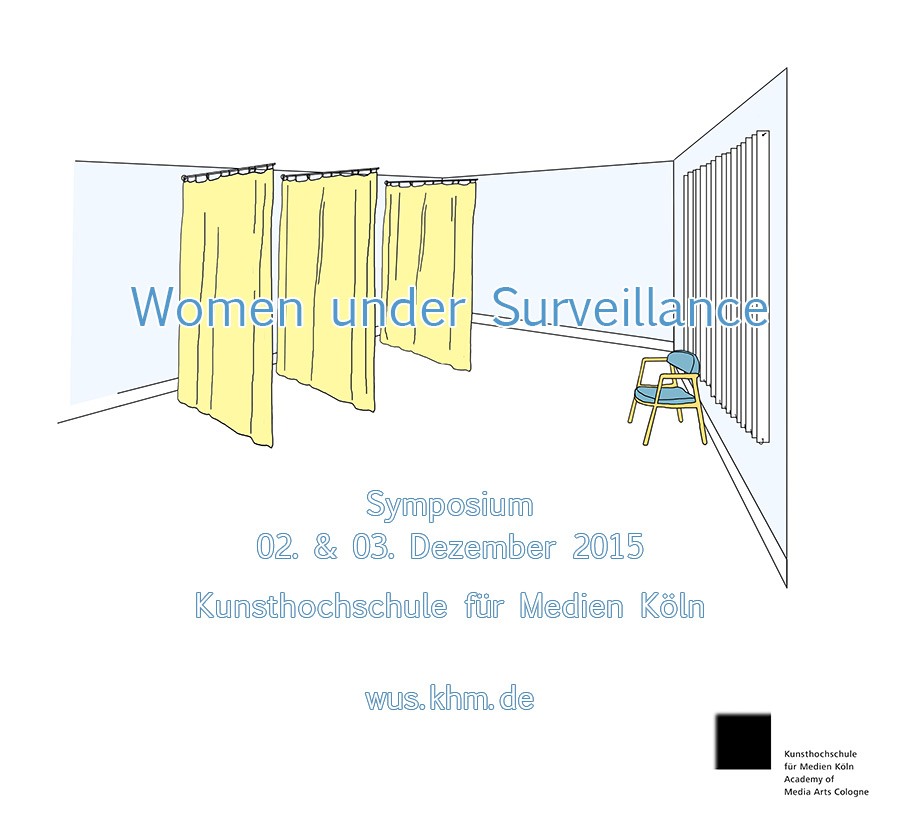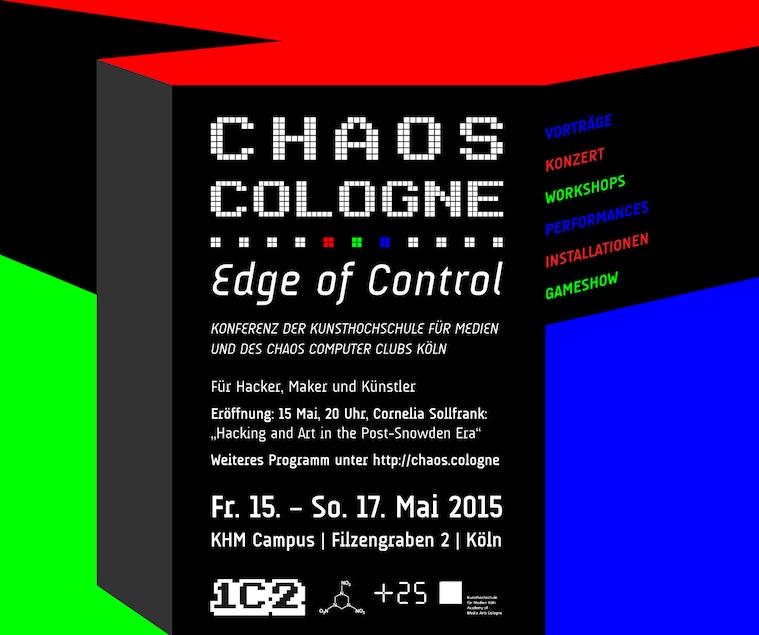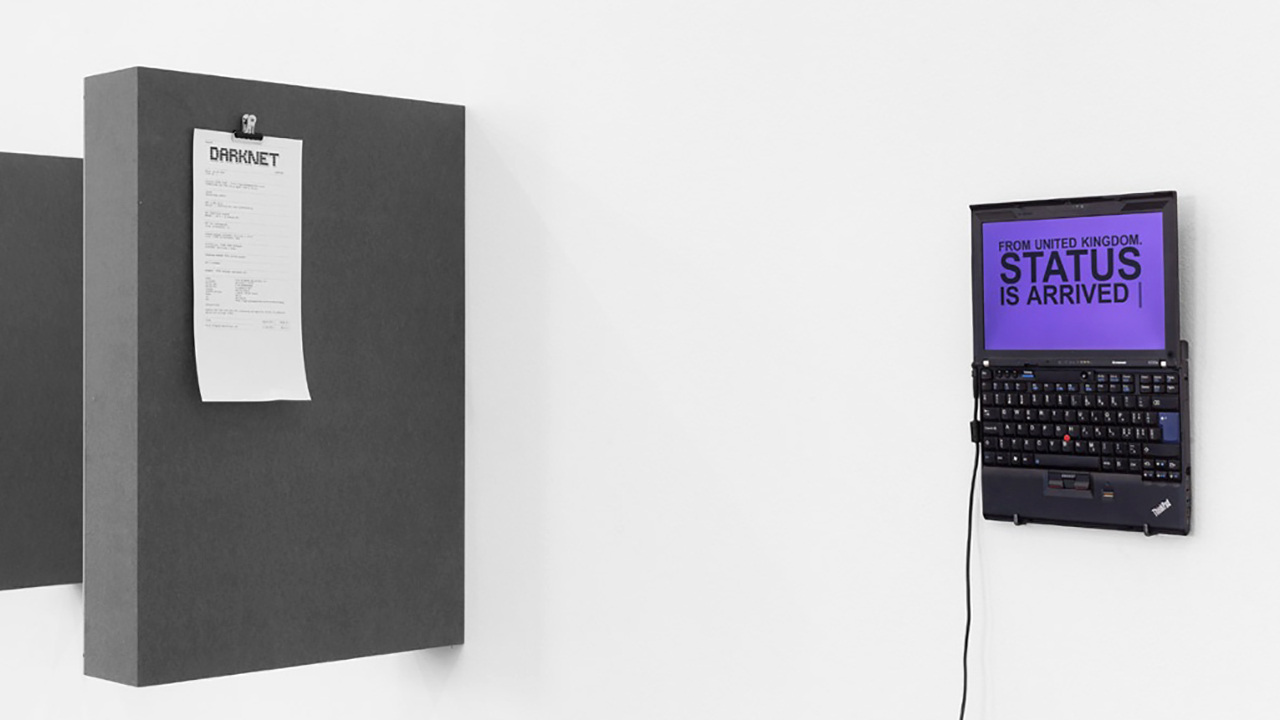Another good critique of the ideology behind CCTV: Esther Hovers’ series False Positives
current
Women under Surveillance Symposium
Please scroll down for English version
Symposium
2. & 3. Dezember 2015
Kunsthochschule für Medien Köln
Filzengraben 2, 50676 Köln
Das zweitägige Symposium Women under Surveillance tritt vermeintlich neutralen Definitionen von Überwachung entgegen. Es führt einen künstlerischen und interdisziplinären Dialog über Überwachung im Digitalzeitalter. Dieses Bezugsfeld wird dabei mit einem besonderen Fokus auf dessen Bedeutung für Frauen diskutiert.
Das Symposium bringt Vorträge, Performances, Installationen und Filmscreenings zusammen, die sich mit Themen wie Datensammlung oder Kontrollobsessionen im Namen der Sicherheit auseinandersetzen.
Ziel ist die reine Diskussion, ob exzessive Überwachung notwendig und zielführend ist angesichts einer zunehmend unsichereren Welt, hinter sich zu lassen und stattdessen anhand geschlechtsspezifischer historischer Überwachungskomplexe, wie beispielsweise der Regulierung der Autonomie der Fortpflanzung und der Sexualität, die Frage zu stellen, wer von wem beobachtet wird, wie, warum und zu welchen Kosten?
Konzeption und Organisation: Prof. Julia Scher, Christian Sievers, Dieuwke Boersma und die Surveillant Architectures Group an der Kunsthochschule für Medien Köln. Filmprogramm kuratiert von Christa Pfafferott. Design von Stephanie Glauber.
Im Rahmen des Symposiums präsentiert GLASMOOG – Raum für Kunst & Diskurs an der Kunsthochschule für Medien Köln „Tektite Revisited“, ein Ausstellungs- und Filmprojekt der Filmemacherin Meghan O’Hara und des Kunsthistorikers James Merle Thomas.
Referenten / Performer:
bankleer (KünstlerInnengruppe, Berlin)
chicks on speed (KünstlerInnengruppe, Köln/Hamburg)
Sophie Maintigneux (Bildgestalterin, Professorin für Bildgestaltung, KHM)
Karin Michalski (Vertretungsprofessorin für Kunst- und Medienwissenschaften/Gender, KHM)
Lívia Nolasco-Rozsas (Kuratorin, ZKM Karlsruhe)
Meghan O’Hara (Filmemacherin, California State University, Monterey Bay, Seaside, CA) & James Merle Thomas (Kunsthistoriker und Kurator, University of Southern California, Los Angeles, CA)
Christa Pfafferott (Autorin und Regisseurin, Hamburg)
Angela Richter (Regisseurin, Schauspiel Köln)
Katrin Schlösser (Filmproduzentin, Professorin für kreative Film- und Fernsehproduktion, KHM)
Dirk Schulz (GeStiK – Gender Studies, Universität zu Köln)
Mark von Schlegell (Autor und Kulturtheoretiker, Köln)
Mi You (Wissenschaftliche Mitarbeiterin, Kunst- und Medienwissenschaften, KHM)
und Studierende der KHM
The two-day symposium Women under Surveillance counters neutral definitions of surveillance to establish a platform for artistic and interdisciplinary dialogue along the lines of women and surveillance in our digital age.
Lectures, performances, installations and film screenings go deeper into the critical means of collecting data and monitoring processes in the name of security and the general interest of the “public”.
The symposium aims to move beyond the discussion whether excessive surveillance is a necessary and productive practice in an increasingly insecure world.
Rather, in taking the gendered history of surveillance strategies as its starting point—such as the regulation of women’s productive autonomy and sexuality—the symposium engages artistically and critically with questions as: “Who is being watched by whom, how, why and at what expense?”
Konzeption und Organisation: Prof. Julia Scher, Christian Sievers, Dieuwke Boersma and the Surveillant Architectures Group at Academy of Media Arts Cologne. Filmprogram curated by Christa Pfafferott. Design by Stephanie Glauber.
As part of the symposium, GLASMOOG – Raum für Kunst & Diskurs at the Academy of Media Arts Cologne presents “Tektite Revisited”– an exhibition and film project by filmmaker Meghan O’Hara and art historian James Merle Thomas.
Speakers & Performers:
bankleer (artist group, Berlin)
chicks on speed (artist group, Cologne/Hamburg)
Karin Michalski (professor for art and media studies/gender, KHM)
Lívia Nolasco-Rozsas (curator, ZKM Karlsruhe)
Meghan O’Hara (filmmaker, California State University, Monterey Bay, Seaside, CA)
& James Merle Thomas (art historian and curator, University of Southern California,
Los Angeles, CA)
Sophie Maintigneux (cinematographer, professor for artistic cinematography, KHM)
Christa Pfafferott (author and film director, Hamburg)
Angela Richter (director, Schauspiel Köln)
Katrin Schlösser (film producer, professor for creative film and TV production, KHM)
Dirk Schulz (GeStiK – Gender Studies in Cologne, University of Cologne)
Mark von Schlegell (author and theorist, Cologne)
Mi You (assistant researcher, art and media studies, KHM)
and students of the KHM

Guest speaker on Nov 11 : Tobias Flessenkemper
Wednesday, 11 November 2015, 10h30-12h00
“The European border regime in South Eastern Europe – between collapse and resurrection”
Tobias Flessenkemper, Senior Associate Researcher
Centre international de formation européenne (CIFE) – European Institute, Nice/Berlin/Istanbul
Tobias Flessenkemper is working on the issue of external and internal security policies of the European Union with a focus on South Eastern Europe and the European neighbourhood. He holds a M.A. of the University of Cologne in Political Science and a European Master in International Humanitarian Assistance of the Ruhr-University Bochum. Since 1996 he worked for international organisations in Brussels and South Eastern Europe and currently manages elbarlament.org an independent organisation working in the field of democratic governance.
Raben und Krähen. Das waren Frauen und Kinder.
Aus der Befragung des ex-Drohnenpiloten Brandon Bryant im NSA-Untersuchungsausschuss des deutschen Bundestages, 15. Oktober 2015
Flisek: Gab es in Ihrer Praxis Fälle, wo es zu Kollateralschäden gekommen ist, wo Menschen im Umfeld des Ziels zu Schaden gekommen sind?
Bryant: Ja.
Flisek: Einzelfälle? Worüber unterhalten wir uns, war das Regelfall?
Bryant: Ziemlich. Drei Kennzeichen: Männer in milit. Alter. Dann Raben und Krähen. Das waren Frauen und Kinder. Sonst Männer in milit. Alter, d.h. über 12 Jahre. Das waren legitime Ziele. Würde sagen, das sind Kollateralschäden, weil nicht entsprechend UN-Terminologie.
Flisek: Per se Männer mit Aussehen über 12 Jahre als milit. Ziele eingestuft – zum Abschuss freigegeben?
Bryant: Ja.
Flisek: Woran hat man das Alter festgemacht?
Bryant: Wussten wir nicht. Man hat gutes Bild von Körper über Infrarot bekommen. Konnte gut sehen: Jugendlicher, Kind, Frau, Mann.
SAG shared calendar with all seminar events, constantly updated.
We have a shared calendar with all seminar dates. Maintained by Christian and Julia in a collaborative effort, this calendar will always hold the latest info about seminar events, and some more stuff we think is relevant to the group.
You can see the calendar in a web page here.
Another way to access it is to subscribe to it with your favorite calendaring application.
To do that, select and copy this address:
https://kalender.khm.de/public.php/sag/SAG-Public-Events/
Then go to e.g. Calendar.app and choose Calendar -> Subscribe (-> Abonnieren on German systems). Paste the entire address including the https://.
Accept and trust the security certificate, and confirm with your computer password.
Make sure to switch ‘Auto-Update’ on (set it to an hour or so).
The procedure is similar on smart phones and with other calendaring apps. Happy to help if you need setting it up!
1st Chaos Cologne Conference
The conference is now over. Its website incl. program can be found at http://chaos.cologne
May 2015: 1st Chaos Cologne conference @KHM, co-organized with CCC Cologne
Organized by Christian Sievers & Mathias Antlfinger/KHM together with Chaos Computer Club Cologne, taking over large parts of KHM for a weekend in May. We had over 550 visitors and around 45 speakers and performers, forming a good mixture of students, artists, hackers and makers. See http://chaos.cologne/ for the program.
Here are videos of the talks, performances and presentations: https://media.ccc.de/browse/conferences/chaoscologne/1c2/index.html or https://www.youtube.com/playlist?list=PL_IxoDz1Nq2Zo6s7JkBA48L6w3terUsFh

Gendered surveillance

When teacher Catharine Higginson, 45, discovered by accident that her husband James, 42, had installed an app on her phone which allows him to track her movements, read her texts and even listen to her conversations she didn’t plan to divorce him as her friends urged, for being creepy and intrusive.
Instead, the mum of three from Dorking, Surrey, says it makes her feel loved and safe
This is beyond creepy (via) . Make sure you get the undertones about the power structures at play here. It reads like an advert for personal tracking apps.
It also completely ignores the huge problem of women being utterly exposed to stalkers through spyware just like the one celebrated in that article. Women (it’s always women) seeking shelter from stalkers now routinely have to go through a digital quarantine, to make sure they’re really safe. See Surveillance Begins at Home and Digital Detox At The Shelter.
Another example why the NSA’s undermining of security standards is so harmful. Everyone’s mobile phones are unsafe by design. All of them have backdoors for law enforcement built in, but it’s impossible to restrict the use of those to only the ‘good guys’. As a result, creeps and criminals exploit them, too. This isn’t just about privacy, it’s about being safe from physical harm. People get killed because of this.
Drug-Buying Robot Artwork Seized By Swiss Authorities
http://animalnewyork.com/2015/drug-buying-robot-artwork-seized-swiss-authorities/
We’re hoping to welcome the artists of this piece, !Mediengruppe Bitnik, as speakers at our upcoming Chaos Cologne conference in May.
